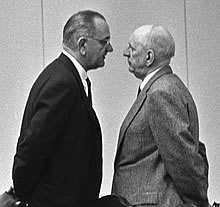The Johnson Treatment. (original) (raw)
Books by
Michael Barr
Order Here:
On December 21, 1966 a group of Democratic governors met with Lyndon Johnson at the LBJ Ranch in Stonewall. The governors were concerned with the volume of Great Society programs and were certain they could persuade the president to take a different course of action.
The Texans at the Alamo had a better chance.
Say what you will about Lyndon Johnson, he was a formidable political force. As Senate Majority Leader no one was better at operating the machinery of government, and he had few equals at the art of persuasion.
Johnson could twist arms with the best. A rival once claimed he could "sell sand to an Arab."
LBJ got results, but his methods were not easy to pin down. He didn't have a typical politician's personality or demeanor. He wasn't smooth, good looking, highly intelligent or particularly likeable.
He was an enigma, even to politicians in Washington. Sen. Richard Russell of Georgia noted "He doesn't have the best mind on the Democratic side of the Senate. He isn't the best orator. He isn't the best parliamentarian. But he's got the best combination of all these qualities."
Johnson's method of persuasion was a complex combination of techniques often described as "The Johnson Treatment."
His ability to persuade began with his physical presence. At almost 6'4", Johnson towered over his colleagues. When talking politics he loomed over and leaned into the other person. He intimidated people with his size and proximity.
He was a big man with an explosive temper. People who felt his wrath usually tried to avoid it in the future.
Few politicians had the courage to say no to Lyndon Johnson. Journalists Rowland Evans and Robert Novak wrote that the "tornadic force of his personality when mixed with the oxygen of politics" was usually enough to steamroll most opposition.

Sen. Richard Russell getting the Johnson Treatment.
Wikimedia
In describing the Johnson Treatment, Evans and Novak noted "Its tone could be supplication, accusation, cajolery, exuberance, scorn, tears, complaint and hint of threat. It was all of these together. It ran the gamut of human emotions. Its velocity was breathtaking and all in one direction."
The Johnson Treatment was relentless. It wore people down. It could last a few minutes or several hours - however long it took to get the job done.
The Johnson Treatment was in full force at the December 1966 closed-door meeting with the governors at the LBJ Ranch.
Six days prior to that meeting the group of unhappy Democratic governors met at White Sulphur Springs, West Virginia. They complained that the president was pushing his Great Society programs along too far and too fast. They accused the president of acting unilaterally. They wanted better communication between the White House and the state capitals.
The governors claimed that the Great Society was becoming a political liability and was hurting them in the polls. They argued that the recent swing in favor of the Republicans was a protest against the president and his policies.
One angry governor told the press that unless the president mended his ways he would be a liability as the head of the Democratic ticket in 1968.
The group demanded a meeting with the president who was on a working vacation at the LBJ Ranch in Stonewall.
The president heard news reports from the meeting in West Virginia and was unhappy that the Democratic governors had gone rogue and were not toeing the party line.
"Come on down to the Purrdenales," the president said. "We'll talk."
There are no official records of that meeting although it would have been fun to be a fly on the wall. What we do know is that after the full-blown Johnson Treatment, Iowa Gov. Harold Hughes, chairman and spokesman for the governors, came outside to meet with members of the press under the oak trees in front of the Texas White House. With little emotion he read the following statement before boarding the plane back to Des Moines.
"We leave here in complete support of the policies, the principles and the precepts as set forth by the president of the United States."
"No further comment."
Sources:
"No Personal Disagreement Between LBJ, Demo Governors," Carthage (MO) Press, December 22, 1966. Rowland Evans and Robert Novak, Lyndon B. Johnson, The Exercise of Power (New York: New American Library, 1966).